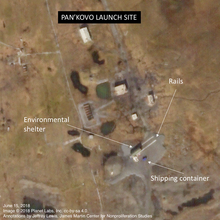Burewestnik (cruise missile)
Burewestnik ( Russian Буревестник , German " Sturmvogel ") is a strategic cruise missile made in Russia. In the GRAY index , the missile 9M730 is designated. The NATO code name is SSC-X-9 Skyfall . The cruise missile is in the test phase.
Technical specifications
Burewestnik is said to have a mini nuclear drive based on a nuclear reactor or radionuclide batteries and thus have a range of over 25,000 km. According to Russian information, it should be able to fly around the planet several times and reach the potential enemy from an unexpected direction. According to the Russian military, the other properties of Burewestnik include its maneuverability and low altitude, which is why it is hardly recognizable by enemy missile defense systems and certainly not destructible. Western armaments experts assume that Burewestnik is armed with a nuclear warhead .
US experts described the technical feasibility of a cruise missile with a nuclear drive as unbelievable due to the disadvantages, but not excluded.
According to western observations, the development of the burewestnik began in 2011. Of the 13 test flights that took place between 2016 and the end of 2019, only two were successful, according to Western intelligence services. According to the US representation, no flight came beyond a flight distance of 22 miles (35.4 km).
chronology
According to a statement made by President Putin in 2018, developments began after the US withdrew from the ABM Treaty in December 2001 in response to the US-driven development of a global missile defense system.
The cruise missile became known to the general public in March 2018 when Putin introduced it, along with five other armaments technologies, in his speech to the Federation Assembly. The name "Burewestnik" (petrel) was chosen in a referendum on the online platform of the Russian Defense Ministry.
The ruthenium release south of the Urals in 2017 may be related to a failed test flight from a Burewestnik cruise missile.
A system probably fell into the sea during a test in October 2018. At that time, no-fly zones ( NOTAMs ) were published. The Njonoksa nuclear accident on August 8, 2019 with seven deaths and a not inconsiderable amount of leaked radioactivity was largely associated with the Burewestnik project. A plausible explanation of the incident based on the information was the attempt to salvage the missile that may have crashed into the sea in October 2018.
In a speech broadcast on November 22, 2019, Putin declared the completion and perfecting of a novel weapon related to the accident. Possession of the weapon would ensure "the sovereignty and security of Russia for decades to come". The day before the speech, he had given the widows of the 7 killed medals of valor posthumously for their husbands.
See also
- Awangard (hypersonic weapon)
- Kinschal ( air-to-surface missile )
- Sarmat ( ICBM )
- Pereswet (laser weapon)
- Poseidon (underwater drone)
- Pluto project
Web links
- Russia Reveals 'Unstoppable' Nuclear-Powered Cruise Missile , The Diplomat, March 2, 2018
- Ракета 9М730 / Крылатая ракета с ЯЭУ , Militaryrussia.com, March 4, 2018
Individual evidence
- ↑ a b c d e f Jill Hruby: Russia's New Nuclear Weapon Delivery Systems - An Open-Source Technical Review. (PDF) In: nti.org. NTI - The Nuclear Threat Initiative, November 1, 2019, accessed January 28, 2020 .
- ^ Russia's New Arms Give the US Room for Pause. Stratfor Enterprises, August 16, 2019, accessed September 18, 2019 .
- ↑ a b Russia gears up to test fine-tuned 'invincible' nuclear powered cruise missile. In: tass.com. TASS , July 19, 2018, accessed on August 16, 2019 .
- ↑ Sean Gallagher: Best bad idea ever? Why Putin's nuclear-powered missile is possible ... and awful. In: arstechnica.com. Ars Technica , March 22, 2018, accessed August 16, 2019 (American English).
- ↑ Amanda Macias: Putin claimed a new nuclear-powered missile had unlimited range - but it flew only 22 miles in its most successful test yet. In: cnbc.com. CNBC , May 22, 2018, accessed August 16, 2019 (American English).
- ↑ Россияне выбрали названия для новейшего отечественного оружия. In: ria.ru. RIA Novosti , March 23, 2018, accessed August 16, 2019 (Russian: The Russians have chosen the names for the newest domestic weapons ).
- ↑ a b "The water column rose 100 meters" , rferl, August 29, 2019 (Russian)
- ↑ Fatal accident: Putin announces completion of new weapon orf.at, November 22, 2019, accessed November 23, 2019.
